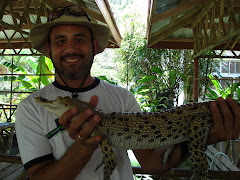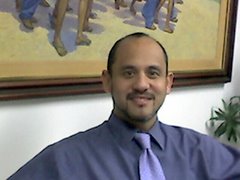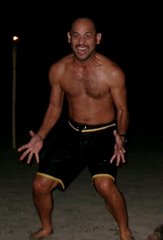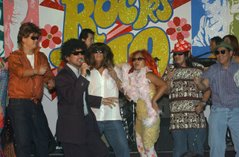 That Sibuyan trip was really memorable and not just because of the boat ride. Mt. Guiting-guiting dominates the Sibuyan landscape. As far back as the 80s I have heard about this legendary mountain named after its jagged, scissor-like peaks. It's not as hard to climb as Mt. Halcon but it's noted to be a dangerous and scary climb because you have to pass through a knife-edged ridge to get to the peak. If the winds are strong and the fog is thick, passing through this ridge can be hair-raising.
That Sibuyan trip was really memorable and not just because of the boat ride. Mt. Guiting-guiting dominates the Sibuyan landscape. As far back as the 80s I have heard about this legendary mountain named after its jagged, scissor-like peaks. It's not as hard to climb as Mt. Halcon but it's noted to be a dangerous and scary climb because you have to pass through a knife-edged ridge to get to the peak. If the winds are strong and the fog is thick, passing through this ridge can be hair-raising.
The usual route is to climb from Magdiwang town and reach Mayo's peak by the end of the first day. On the second day, you drop your pack and assault the peak via the knife edge and then back again to the Mayo's peak camp site to spend the night. By the third day you are back in Magdiwang. Its a good itinerary that's been well developed since the 80s. But the weather can be tricky at Guiting as we were to find out. It's even more unpredictable during a La Nina year like 2008.
In the mid 1980s 4 mountaineers from UP perished on this mountain. The 4 were acquaintances and part of that friendly rivalry between our UP Divers Club and the UP Mountaineers. Their deaths were brought to my mind again a few days ago. 4 mountaineers from AMCI were caught by a flashflood while climbing down a mountain in Zambales at the height of Typhoon Frank. One of the climbers survived unlike those in Sibuyan. The townfolk of Magdiwang still remember the day when the bodies were brought down from the mountain over 20 years ago. When they retell the story, first names are used to describe the 4. It was with this in mind that I started my trek.

It was already mid April but intermittent rains were still falling. The peak was almost always obscured by thick clouds. After an hour or so of hiking we had entered the thick forest that Sibuyan is best known for. At this point, we knew that this wasn't going to be an easy stroll. Poor Ed was already struggling despite having a porter to carry most of his stuff. All through out the climb I was worried about him and I was wondering whether he would ever forgive me for suggesting we climb Guiting-guiting during this project site visit.
The ascent was gradual at the start but before long it became steeper as we moved through the thick forest. Even if it wasn't that hot and we were shielded from the sun by the thick foliage the humidity was stifling. Beads of sweat were running down my face and eventually I was soaked from head to ankles (I managed to keep my toes dry using thick socks). The guide and porters looked they were off on a Sunday stroll. The 2 porters had slippers on and despite that their surefootedness was astounding. Although the forest was thick, the trail was well established and the first 4 hours wasn't so bad. Eventually though we came upon a thicket of thin bamboo that kept getting snagging us. After 5 or so hours of walking, having these crooked little branches holding you back can be very infuriating. After the bamboo thicket the climb got a bit less irritating and a lot more scary. We were on all fours climbing up a 70 to 80 degree slope. Not easy with a full 40 kilo pack. Although this was the best place to admire the view, you can't really enjoy it when you're clinging on to dear life. Almost one and a half kilometers straight down was Magdiwang with its famously clean rivers meandering from the Guiting slope. After 9 exhausting hours we were finally at the camp site on Mayo's Peak. The camp was damp, muddy, misty... in short, miserable.
 At least the rain wasn't continuous and it allowed us to pitch our tents and cook without too much difficulty. Sleeping was tough especially when you accidentally set up your tent right on top of a big tree root. It didn't help that someone was snoring so loud it made the thunder sound mellow. My North Face tent was great and it held up well despite the rains and flooded camp ground. The next morning I could feel a big puddle of water under my tent (obvious poorly set up) but the inside was dry and the cold temperature inside was tolerable.
At least the rain wasn't continuous and it allowed us to pitch our tents and cook without too much difficulty. Sleeping was tough especially when you accidentally set up your tent right on top of a big tree root. It didn't help that someone was snoring so loud it made the thunder sound mellow. My North Face tent was great and it held up well despite the rains and flooded camp ground. The next morning I could feel a big puddle of water under my tent (obvious poorly set up) but the inside was dry and the cold temperature inside was tolerable.As we ventured out of our tents to have a look at the peak though, it was obvious that we weren't going any higher. We could see no further than 10 feet in front of us, and pushing through with the knife edge traverse would be unsafe. That day, the mountain had decided she was closed to visitors. Our guide said that his estimate is only about 70% of those that start out climbing Guiting ever reach the top mainly because of the weather. I needed no convincing and I told the group I was ready to go down.
If the 9 hours going up was exhausting, the 8 hours going down was excruciating. I knew I wasn't that well prepared physically for the climb. My strength and endurance training was barely a month long and I was relying on my banked fitness and mental toughness to get me through this. The leg presses served me well and my legs hardly cramped on the way up but my muscles seemed very unprepared for the downhill stress. My legs were quivering and there was muscle pain on almost every step. Luckily, my reconstructed Anterior Cruciate Ligament (ACL) on my left knee was not a problem. In fact there was no palpable difference between my left and right leg.. both felt terrible. Every so often, my legs would buckle under me and I would end up sliding down on my ass.

It was night fall by the time we got down to the ranger station and the rain was pouring. A few minutes earlier we had made the stupid mistake of cleaning up at the river but we were again muddy from the short slippery walk from the river to the station. It seemed strange that we were complaining more about the last 30 minutes when we had gone through a total of 18 exhausting hours of hiking.
(go to my Sibuyan photo album for more photos).









